by Tom Gaylord
Writing as B.B. Pelletier
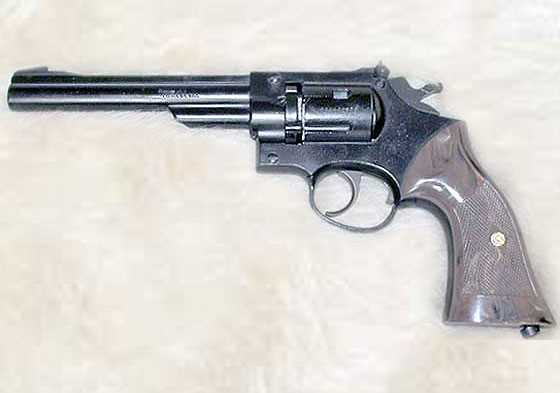
Crosman 38T.
This report covers:
- The test
- Lotsa pellets
- Jim outshot BB
- Getting tired
- The next day
- What the heck?
- BillJ — this is for you
- Summary
Well, I’m hot into it now, and as long as that’s the case I decided to do the accuracy test on the .177-caliber Crosman 38 T Target revolver. Reader Jim M. was down for a visit and to help me pack up all the guns and stuff I’m returning to Pyramyd AIR, so when we finished I thought I would let him get in on the test, too.
The test
We both shot from a rested position at 10 meters. The revolver was rested directly on a sandbag and we used a two-hand hold. We shot with a 6 o’clock hold on the bullseye and we shot 6-shot groups, since that’s how many pellets the revolver holds.
Jim and I both shot on the first day. But I also shot again alone on day two.
I backed the bullseyes on the second day of the test with white duct tape to help the pellet holes show more sharply.
Lotsa pellets
I had no idea of which pellet or pellets this air pistol might like, so we went through a lot of them! Actually, Jim and I shot a great many targets until we both seemed to tire — or at least I did. After all, we had been working for several hours packing boxes and accessories and checking them off a spreadsheet.
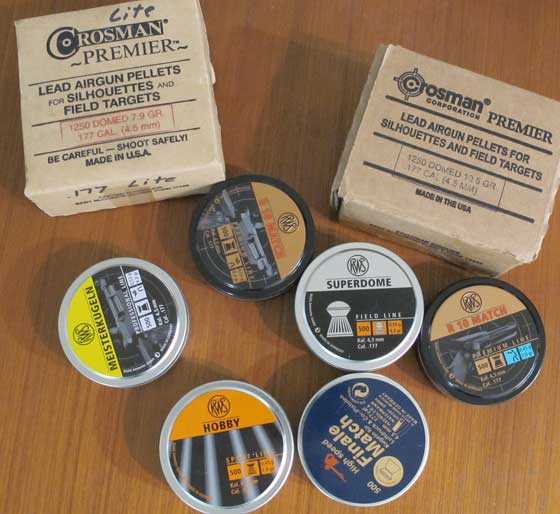
We shot many pellets on the first day and I added a few more on day 2.
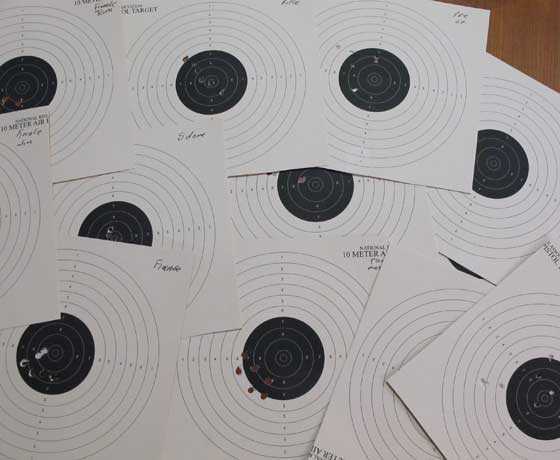
And we shot more than a few groups.
Jim outshot BB
At first Jim was not familiar with the heavy trigger pull, which on this 38T is 4 lbs. 14 oz. But he adapted quickly and soon proved to be the better shot. Of the four different pellets we tried this day, H&N Finale Match High Speed proved the most accurate. I put 6 into 1.401-inches at 10 meters and then Jim trounced me with 6 in 0.831-inches at the same 10 meters.
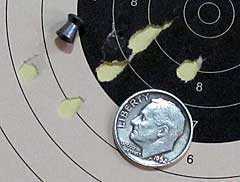
I put six H&N Finale Match High Speed pellets into 1.401-inches at 10 meters.
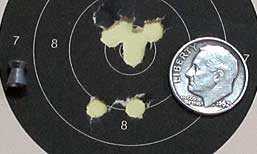
And then Jim put 6 into 0.831-inches to skunk me!
Getting tired
We shot so many groups that I had to change the CO2 cartridge. Jim and I had worked a lot before that and I was pooped, so we called it a day after shooting 8 groups. But I was not satisfied that we had tested the pistol thoroughly. So I left the indoor range set up, vowing to resume shooting the next morning when I was rested.
The next day
The next morning I picked up where I left off. The CO2 was still good, as I had replaced it just before shooting the final group on the previous afternoon. I started with three different pellets — The Crosman Premier Light, the Premier Heavy and the RWS R10 Match Heavy pellet. All three gave me open groups that measured over 1.5 inches between centers.
At that point I figured I could either wear myself out again trying different pellets or I could return to the one pellet that both Jim and I shot the best the day before — the now-obsolete H&N Finale Match High Speed. It’s lighter than the current Finale Match Light, but that would be the place to begin to look for something equivalent.
On day one I put 6 of them into 1.401-inches, center-to-center. This day I put another 6 into 0.981-inches and almost in the same place on the target. I had adjusted the rear sight to the right at the end of the day before and hadn’t touched it since.
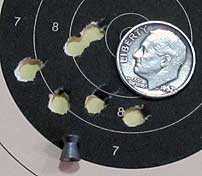
On day two I was fresher and better able to concentrate. These six Finale Match High Speed pellets went into a group measuring 0.981-inches between centers.
What the heck?
As I was ending the test I decided to try just one last pellet — the RWS Superdome. Lo and behold, six of them went into 0.97-inches at 10 meters. And not only that but without adjusting the rear sight they went to the center of the bull. When I use the right pellets this 38T can shoot!
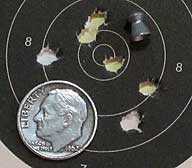
This group of 6 RWS Superdomes is my best group of the test. It measures 0.97-inches between centers.
At this point I was inspired to shoot a second group of Superdomes, to prove that the first group wasn’t a fluke. Then common sense prevailed and I said, “Naaaah! Why tempt fate?” I’ll just pretend that I can pick this revolver up anytime and shoot another group just like this one.
BillJ — this is for you
Reader BillJ commented that Crosman ashcan pellets were the best in his 38T “back in the day.” Here is what he said.
This column made me recall when I had a 38T (in .22, mid 70’s). I suppose that I should have never sold it. But I broke the rear sight (plastic), couldn’t glue it or replace it so I sold to a guy that I worked with that said he’d take it, as is.
As I recall, it was fun to shoot and ‘reasonably’ accurate (tin can wise), before the rear sight went away.
The pellets that I used to shoot were the Crosman ‘ash cans’ and also AmPell pellets.
I found these ‘on the back shelf’ (see picture) and weighed a few. The weights (in grains) were:
16.2
14.3
16.0
14.8
16.0
16.0
14.8
16.0
16.2
15.8
I can only guess that quality control was somewhat short of what it is now.
“I have kinda poked around the internet, and haven’t seen any new ashcan style for sale (but I wasn’t looking too hard).
When I said that those were found ‘on the back shelf’, they really were. I bought these for use with the 38T that I had in 1977, so they are over 40 years old! (The price tag on the side says $1.50.)
Even if they were available, I don’t know that I would get any new ones unless the QC was way, way better.”
Bill
Well, I have a supply of .177 ashcans, so we are up for one more test. Next time I will test with vintage Crosman ashcans, RWS Superdomes and RWS Superpoints in this 38T. I just wanna know, and a bet a lot of you do, too.
Summary
Though it may be 40+ years old, this one hangs in there with the best of the modern air pistols. I’m looking forward to the next test.
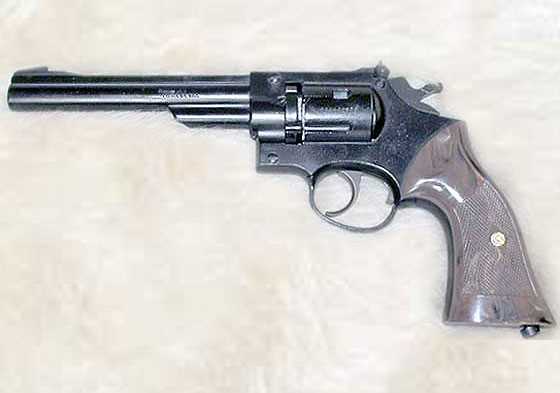
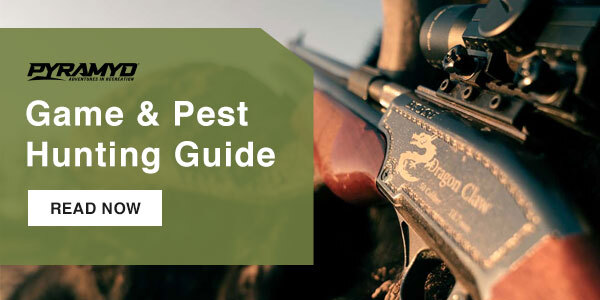
“I just wanna know, and a bet a lot of you do, too.”
Yes, B.B., I do want to know! =>
P.S. Thank you for doing an in-depth report on these pistols; as you’ve shown here, these ol’ gals can shoot!
BB,
Yes, as you well know I have a strong affinity for the old gals. I also am not much for CO2 or the lookalikes, but I do like to read and study up on them. It is quite amusing to me that this grandma can hang with the best of the kids running around out there right now.
I have a project for of these CO2 makers. I would like to see one or more of them make high quality reproductions of some of the Giffard CO2 guns. I know they would cost, but I think some airgunners out there would like to get their hands on something like those. Not just something for the couch commandos to play with for a season or two, but a well made airgun to be passed down through the generations.
I know that is counter to the present business model. Everything these days is meant to be disposed of after a short period of time and we are supposed to do such and spend our money on the latest and greatest whizzer. But I kinda like the older stuff. Maybe it is because I am some of that older stuff. Maybe I have been around long enough to know better.
I drive a 2004 Ford Ranger 4×4. It could use some new seats and a paint job, but I keep it running like a new one. I have to. it is much cheaper to do that than to replace it. Do you have any idea what they want for a new Ford Ranger 4×4? I can totally overhaul mine a couple of times for what one of those cost. Mine is paid for.
These old airguns are not made out of pot metal and plastic. They are made out of good quality steel and usually walnut. With just a little TLC, most of these are every bit as good as the new ones and some are even better. The funny thing is most of these are cheaper than something of the same quality built these days. it would cost a lot of money to exactly copy some of these ladies around here.
RR,
A low-volume airgun like a Giffard might be a project for someone like Dennis Quackenbush. They would cost a lot with their loading tap and sales would be limited to less than a hundred worldwide.
BB
B.B.,
To break even, they would have to be $3000 – $4000 a piece.
Michael
Michael,
It would be a lot, for sure.
BB
BB,
I know it would be a very limited market for this. Also, after the last tirade of his concerning the Aramath, I would be most reluctant to broach this subject with him. 😉
B.B.,
If you have the ammo. I’ll bet the .22 will outshoot the .177 pellet to pellet.
Michael
Michael,
I don’t know that I have any .22 ashcans. But it will be interesting to watch.
BB
I picked up another 78g to flip and it came with a vintage Crosman tube of .22 ash cans.
I will send you some.
Ian.
Ian,
Could I please have 12?
BB
I will give you half of what is in there, (its pretty full) so you will have some on hand for future vintage testing.
Ian
Ian,
You are too generous! Thank you,
BB
Michael
Did you think about that after your time expired to edit?
Why do you think the .22 will out shoot the .177?
Gunfun1,
Everything else (air gun, pellet) being equal, .22 usually comes out on top, accuracy-wise, or at least that is the impression I have gradually been left with from reading this blog for 10-plus years..
This seems especially true, in my personal esperience, with CO2 pistols. For example, I have a Crosman Colt SAA replica in .177 that shoots OK to decent. But my same era Crosman/Hahn SAA in .22 I can’t miss with at 30 feet or less. I can shoot so well with it, I’ll never part with it. The same goes for my S&W 22 caliber 78G and .177 caliber 79G. The 78G is more accurate.
Michael
Michael,
Those are my findings, as well. It’s funny but Dr. Beeman said just the opposite.
BB
BB
Are you referring only to CO2 guns? I think you have said there is no accuracy advantage for either .177 or .22 over the other in general. Let’s say the distance is 25 yards and shooting indoors. Only the choice of premium pellets is greater for.177.
Deck
Deck,
Of course there are a lot of considerations. Perhaps I shouldn’t have agreed so easily. 😉
BB
Michael
Weird.
Wonder why all 10 meter competition guns are .177 caliber.
And I have experienced .177 caliber pellet guns to be more accurate than .22 caliber. Go figure. 😉
BB,
Glad it is still shooting well. Looking forwards to the ash cans. Maybe weigh a few just for the record while you have them out?
Chris
Chris,
You betcha!
BB
BB
Maybe I should point out that the pellets that I weighed were AmPell .22 ‘ashcans’ not Crosman.
I don’t know whether that might have made a difference or not but I wouldn’t want the Crosman product to be dismissed without any actual evidence.
Bill
Bill,
That makes a huge difference. But mine are Crosman, so we will get a true test in the end.
BB
BB,
Since I was not eating Brontosaurs burgers as a kid,… I would have no clue,…. but you might. 😉 I wonder just how much (pellet) rebranding was going on back then. ? Same product, same molds, same factory,… new name/label/tin. Certainly not unheard of in today’s market.
Chris
Chris,
It was happening back in the 1940s for sure. Making pellets is a major process and few companies wanted to try.
BB
BB,
I have about 30-35 .22 cal Superpells as well as 170 .177 Superpells. In addition to those, I have about 275 Copperheads in .177, which appear to be the same as the Superpells, but have not taken on nearly as much oxidation, in spite of being bought around the same time, that being late 80s early 90s. Maybe the harder alloy was introduced at that time. I don’t know.
I think they all would enjoy the remainder of their life much better knowing that they may have a chance to be fired from some pellet guns that were popular during their youth, so if you would like to have them to test in some vintage guns in the future, just tell me how to get them to you. I also have some .177 pointed pellets that look like they were turned on a lathe that I believe are Beeman Silver Jets. I have them in a TicTac box, so I don’t know for sure. You’re welcome to them as well. I won’t ever test them in any of my future guns because my purpose in testing is to find available pellets that shoot well in the guns.
While we are talking about pellets, why didn’t you, since you seemed to be favoring wadcutters in today’s test and since we know that your natural tendency is to shoot the pellets that the gun maker produces, if they make pellets, in the guns they produce, shoot any of the cheapo Crosman Competition Wadcutters that come in the milk carton. They also come in clamshell packages but they are cheapest in the 1250 count milk cartons and they are most recently marketed as Premier Wadcutters and can be found in tins as well. I find that they perform pretty good in inexpensive guns that use a rotary type magazine like the 1077 and the various CO2 revolvers that Daisy and Crosman make. I think the hardness of the pellet helps keep it from deforming when it must jump a gap between the cylinder and barrel. I don’t recall you ever using those pellets in your tests, but that doesn’t mean you haven’t, ’cause my “recaller” frequently abandons me these days
Half
Half,
I accept your generous offer. I’ll be in touch.
BB
Chris,
I have some heavily oxidated .22 SuperPells, aka ashcans, that are 17.4 gr. The same Superpells, also fairly oxidated, in.177 weigh 8.3 gr. Those same pellets were later marketed as Copperheads and my small supply is not nearly as oxidated, in spite of being bought around the same time, and they also weight 8.3 gr.
Half
BB,
Nice results with the duct tape. That is pretty typical results. As you can see,… some are perfect and others are so-so, with most real good. I use a medium-heavy copy paper (not proper bought targets) but the results are very similar. I do not shoot wad cutters though, only domes.
Bottom line,… using duct tape direct to back of target is better than not using it.
Chris
Chris,
I’ve had good luck with card stock.
Michael
B.B.,
Only one target (…six H&N Finale Match High Speed pellets into 1.401-inches…) you showed had what I would identify as pellet instability. The paper tear shows a consistent point toward 2 O’Clock. I know you shot indoors so the ambient temperature should not be a factor which only leaves gas temperature, gas to liquid ratio, seating depth, or since it is a handgun the vibrational dampening of the hand holding the piece when you two shot the same pellets.
So the question is: Was any clue on which factor or combination made apparent on the targets we didn’t get to see?
shootski
shootski,
I guess that was something I just didn’t look at.
BB
B.B.,
GOOD answer, LOL! ;^)
shootski
Another FM unscientific test, “for amusement purposes only.” Found groups with .22 “ashcans” at 25′ on the homemade target were not as tight as with the .22 Crosman 14.3 gr hollowpoints at 40′ or 12.2 meters. Qualifiers: groups were fist-sized at best; 38T fired two-handed, not rested on anything; FM is a 1.5 eyeballs guy. The sight did not seem to need adjustment. Nevertheless, FM concurs with B.B.’s impressions, based on this faulty test and past recollections – the Old Gal or “ORK” can shoot.
Question, in the interest of not damaging the CO2 cylinder securing screw head, as FM did in his immature/inexperienced days, what would be the kinder-and-gentler tool to use for this purpose – or perhaps technique? In lieu of, or in addition to, a big, fat, flat-bladed screwdriver?
Monday off-topic topic: attended a local gun show yesterday after a non-attendance dry spell lasting over a year; it was livelier than expected and a fairly good experience. For the first time, FM noticed a vendor displaying mostly airgun and airgun-related products, including a Umarex Airbow, Daisy Powerline rifles, and at least one SIG P365 CO2 pistol. No .22 pellets, though…saw only some Crosman .177s. Hopefully it is a sign other airgun enthusiasts and/or vendors will start showing up for future shows – choice is good!
BB and friends,
Gas struts, gas rams, gas sproings etc.
The dirt so far. In a nut shell: the gas ram is assembled in a shop. They fill it with gas by forcing gas past the seal. ( Easy in, hard out.). A sealed unit has is no way to let gas out. ( A valved unit can let gas out. The business I talked to do not do them as they leak…and they come fully charged = super strong ) .
So what you do is get a strut made with N amount of gas, try it out. If it is tooo weak then you add more gas. Once you have too much gas in it you have gone too far. Wait a very very very long time and it will go flat.
Caveat : The gas ram has oil in it to lubricate AND to dampen the strut excursion*. The correct amount of oil for a spring gun is… I know not. AND this: The size has to fall into several common options: Shaft /Tube diameter in mm. 8/19. 10/22. 14/28. They make to X excursion with min and max. No idea what they are. They want to see my gas ram to decide. Excursion = how far your ram extends normally. I think the ram has to stop before hitting the inside of the tube for obvious reasons, so shaft preload is important ( stops the shaft from going all the way…)
I have talked to Simon in Auckland NZ from Gas Strut Services who was really cool, interested and we talked for quiet some time. He can make a strut for $120 NZD with low gas, then we can tinker with the gas level till I am happy. Also he has a peer, Ted, in my town who can also do the gassing. So I can get the ram made, sent down, and then fettle it here in my town.
Food for thought! – Robert.
PS. Regasing is super easy. and in fact you could have a selection of rams of different pressures.
PPS. My gas ram: Shaft = 8mm. Tube = 19 mm. Excursion (max) = 109mm**. Tube length = 137mm. Shaft length = 113mm. Rating = 60kg / 600Newtons.
* Replace Excursion with stroke as you see fit.
** This is how far it will stick out when fully extended ( the shaft is now hitting the seal inside the tube) . I have no idea how far in it goes if you want to full compress it. It will “coil bind” at some stage and pressure will go up ridiculously. Slapping any old size gas ram in a rifle etc is not a good idea. It has to have the right dimensions for compressed and uncompressed stages, and it needs to stop moving before it hits the end of it’s full excursion to prevent it hitting the seal and trying to smash it’s way out of the tube. But free drama! Safety: Wear safety glasses and stand well back. Use string to trigger to test. Actually do not do any of this at all. This is not “learn by your mistakes” thing. Danger.
Robert,
Sounds like the proverbial “rabbit hole” to me,.. with little control on your end.
On the other hand,… if a springer can be over sprung,…. then I suppose a gas ram can be over gassed. For simplicity and control,.. I would stick with springs.
Keep us posted as you delve into the gas ram world. I suppose that in the world of springers,… the gas rams are the dark side. 😉
Chris
Chris USA,
I dunno ( about the dark side part …) , the thing is they seem pretty cheap. A gas ram can be easily recharged. It literally takes seconds.
If I get the gas ram at the right pressure then… spring thwanggggggg and shudder, resonation etc is gone as I am not using one!!!
Frankly the 3mm dia spring that I use is plenty of power for 50m and dispatches rabbits quietly and efficiently. Essentially my gas ram is waaaaaaaay too strong and could be dialled back quite a few notches. If I can do this for $120 NZD then I think it’s money well spent, I can sell my uber gas ram for cost. Or… I go back to the 2.3 mm spring and keep on sproinging… at low power. Maybe not getting dinner in the process. Unless I stalk well. Speaking of which I will be trying out the 2.3mm spring next out to 50m to see if it is even viable. If it is I will take to the range on range night and see how it does at 21m…. My groups should be way tighter. : – ) Robert.
BB. A Question: If the 3mm spring I have compresses at n Kg’s then if I match the gas ram to the same amount of compression force…would I get get the same, roughly, FPS? So a scale in Kg’s and some lever rig to test the compression force. Will whip one up! Robert.
PS. I am going to do some science/engineering experiments on springs! Woo!
Robert,
“If I get the gas ram at the right pressure then spring thwanggggggg and shudder, resonation etc is gone.”
Well,.. that would be the goal.
To me,.. they do the same thing a spring does,.. just with different tech.. In theory, the gas ram could be more problematic (more parts).
The only advantage I have heard of gas rams is that they can be left cocked longer. I do not recall a smoother shot cycle ever being cited.
Are they supposed to have some sort of buffering/smoothing effect to the shot cycle? (vs a spring?)
Chris
Chris USA,
I’m obviously, as you know, no expert on break-barrels but with the gas spring in the SIG SSG ASP 20, .177, after the first 70 pellets downrange I’m wondering what the big deal is about magnum spring piston airguns. As I have NO experience with magnum coil spring airguns my thought is it must be the SPRING “…thwanggggggg and shudder, resonation etc…” that RobertA speaks about…but like I said, WHAT DO i know!
So far I really like the rifle. It does feel like it recoils about as hard as the DAQ .308 shooting 130 grain bullets at well over 900FPS! That level of felt recoil did surprise me.
shootski
Shootski,
See my brief reply to Robert.
Chris
Chris USA,
The twang shudder etc is the spring wobbling around in the spring tube. It’s is a long wobbly thing. The gas ram is not wobbly very much if at all. Ergo the spring wobbly is not present with the gas ram.
Gas ram has one more moving part than a spring. So that makes a grand total of two. ( do a pair of scissors have one or two moving parts?) and springs are no angels either, they are totally dependent QC and engineering! The magic is baked in. : – )
The gas ram I have is very hard hitting when it goes off. It’s like it is trying to shoot the entire end of the rifle off.
There is a possibility to dampen this by the addition of more oil into the ram. Springs on the other hand seem to be less violent. Though I am sure a 60kg spring in my rifle will probably be just as violent as a 60kg gas ram.
The gas ram in theory should deliver a less twang, shudder wobble shot. But it seems that the industry have decided to go with increased horse power rather than drivability. The escalating FPS battle. Frankly they need to cut the b* and do some real tests with various power Gas Rams to show the merits of different powers vs accuracy vs shootability vs comfort. and those gas rams are not going to be kind on scopes at all. Imagine a medium power gas ram that is a delight to shoot has good power at 50m ( my optimal range…) and is not a scope smasher !?! My big spring is OK, it has enough power with 8.6gr pellets to keep me happy and not hungry BUT it’s never going to accurate with the wobble etc etc. Groups at 50m will always be tennis ball size. ( Great when tennis balls are in season…) Robert.
* Rhymes with pool. If you are a Kiwi…
Robert,
You bring up some good points. Either way,… we are trying to tune something better that should have been done at the factory.
I can’t speak to gas rams,.. but with a springer,.. proper lube, inner and outer guides and not having too much spring will get a smooth springer.
Both camps could do much better. Keep at it. I admire your drive.
Chris
Chris USA,
Thank you. I really do like modding stuff. It keeps me sane! Yes I am starting to see the points about less spring is smoother. Also I found forestock screws had come lose. Need some really good locking compound. May try different grease with the strong spring. Have plastic card inserted in piston. good clearance. Makes a difference.
The lower powered gas ram I feel is the better solution over all. There is simply no waggle in the power unload and it’s not springing back and forth etc. If I can reach out to 50m and at least embed in soft ply wood I will be happy. If bounce off… not so happy. This is my chrony! Robert.
B.B.,
It was great shooting with you. Thanks for letting me in on some of the fun – and trusting me not to put a hole in your wall! Ha ha. That trigger sure felt heavier than 4 lbs 14oz. I guess shooting that target pistol first spoiled me. I was tired too. I guess we worked harder than I realized, sorting and boxing those air guns. And I think you sand-bagged a little on your group, just to make me feel good. — Smile! —
Thanks again!
Jim
Jim,
Thanks for saying that publicly. I’ll get your money out in tomorrow’s mail! 😉
BB